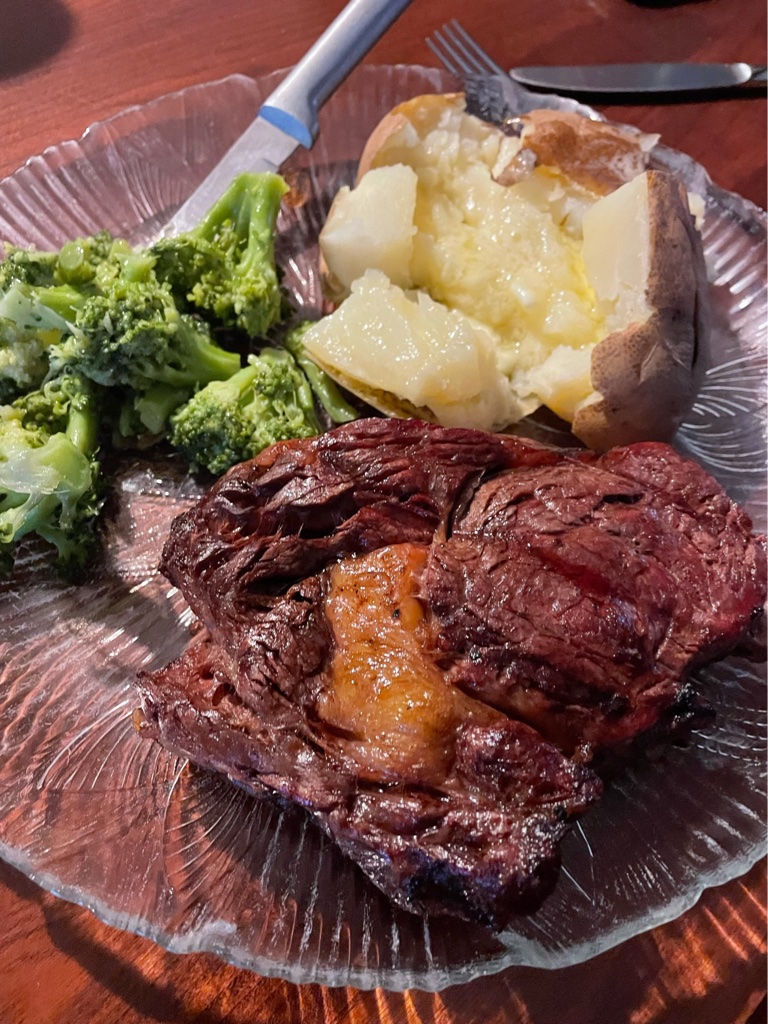I truly adore steak, I love the simple flavor of a delmonico, seasoned with salt, seared in a cast iron, and finished with butter. But, I’ll admit, I’m not a real steak purist, because what I love even more is marinating steak!
Great Steak Cuts to marinate
While you can marinate any cut of steak, there are certainly some that I prefer to use this method with, as it helps to tenderize them. A classic is the skirt steak which is often used in carne asada. The skirt steak is a thin steak that comes from the plate section (the belly), right beneath the ribs, and has very visible muscle fibers. Flank steaks are also perfect for marinating, they come from the flank area which is between the plate and the rear leg of the cow. They are generally very lean and more of an oval shape when compared to a skirt steak.
The skirts and flanks have become so popular, and since each beef only has 2 of that cut, they sell out quickly. We offer some great alternatives to these two steaks! Recently we added the lesser known denver, sierra, and bavette steaks to our line. The bavette is also known as a flap steak, or bottom sirloin. The sierra steak comes from the chuck section which is in the shoulder region. Since we have Jersey beef, our sierras are generally much smaller than our bavette steaks. The bavette comes from a similar area to the flank steak and is often slightly thicker than the previous cuts. The denver is a larger cut, but it is the most tender of these steaks, with fantastic, buttery marbling.
Another great substitute for the flank steak is our flat iron. It is quite similar to the flank steak, however it comes from the chuck and is more tender. This steak is generally between 3-8 ounces making it perfect for a smaller serving. Perhaps the most under appreciated steak is the petite tender which also comes from the chuck region. This cut is very tender as the name suggests, but it is a great steak for grilling so I still love to marinate it!
Finally, our ranch steak is not to be missed by those that love a leaner steak. These little steaks come from the chuck and are lean and flavorful. Due to their small size they can thaw and cook very quickly! The ranch steak can definitely benefit from marinating, and I also suggest cooking them carefully as they can overcook quickly.
Marinade Ingredients
I believe that the perfect steak marinade is comprised of 4 main components: oil, acid, sweetness, and salt. The amazing thing is that these all come with such a wide variety of ingredients that with this simple formula you can make so many different flavor combinations!
For the oil I generally stick with extra virgin olive oil since I usually have it on hand, but other options include avocado oil, grapeseed oil, or coconut oil. Oil can solidify while you marinate your meat in the fridge, so I generally take my steak out about 30-45 minutes before cooking to come up to room temperature and this is not a problem.
Acid is the ingredient that helps to tenderize the meat as it denatures the proteins, and it is one of my favorite components to select because there are so many options. Citrus juices such as lime and orange are a lovely options, especially during citrus season! However, my true passion is vinegars, whether it be champagne, balsamic, apple cider, red wine, or a flavored vinegar. With switching out the acid, you can create a completely different flavor in the end.
When it comes to my sweetness component I generally reach for honey or maple syrup, but there are other alternatives such as brown sugar, agave, fruit jams, or pureed fruit! Adding any of these to your marinade will help to balance the acidity. Finally, the salt, which can come in the form of salt crystals such as kosher, pink himalayan, or sea salt. It can also be added to your marinade with sauces such as soy sauce!
Once you have at least one form of each of the four main components in your marinade then you can add your extras. These can be fresh or dried herbs, seasonings, or sauces. You can also add minced alliums such as garlic, shallots, onions, and scallions. I add worcestershire sauce for an extra hint of umami, or hot sauce for some kick!
The Marinating Process
I usually marinate my steaks in bags, either plastic or reusable, as the flexibility of the material allows me to use less marinade overall. I can also mix up the marinade directly in the bag before adding the meat, it is so easy to combine the ingredients by simply squishing the bag! When it comes to amounts of each marinade ingredient I have to admit that I eyeball it all to eliminate dishes. However, I would say that I generally aim for equal amounts of oil and acid, with generous splashes of all of my other ingredients depending on potency. For example, I would use much less kosher salt than soy sauce as it is more concentrated. I have included a few sample marinade recipes at the bottom of this blog to help spark some ideas!
Once you have prepared your chosen marinade it is time to prepare the meat. Many of the steaks that I mentioned above may have some silverskin on them, which I prefer to remove to help the flavor penetrate and for the sake of tenderness. You can remove silverskin with a paring knife or by pulling it off using a paper towel to help you grip it. After removing the silver skin, if necessary, you can cut your steak into pieces if you wish, or leave it whole. Then, simply place in your bag and refrigerate until about 30-45 minutes before cooking as previously mentioned. It is not necessary to marinate your steak overnight if you do not have time, even 30 minutes can impart great flavor into your steak! I have even put a frozen steak in a bag of marinade and placed it in a bowl of cold water to thaw if I’m in a pinch.
Cooking Marinated Steak
When it comes time to cook your steak the first step is to remove it from the marinade and pat it dry. You can discard the marinade or reduce it down in a pot or pan as a sauce. If you choose to reduce the marinade, be sure to cook it for a few minutes to kill any pathogens. Many of the steaks that I mentioned earlier are best when cooked quickly at a high temperature to medium rare, this helps achieve peak tenderness. To do this I love to grill when the weather is nice. When using a grill I recommend grilling at high heat (about 400-450° F) until the steak reaches 130° F, flipping halfway through. The time will vary depending on the size and thickness of your steak so a meat thermometer is your best friend. As many of these steaks are quite thin it is best to babysit your steak to prevent burning one side or overcooking it.
When I don’t want to fire up the grill I will turn to a pan, generally my grill pan, but a cast iron is also great! The process is quite similar when using a pan, however I use medium-high heat as much more of your steak will be in contact with the cooking surface and the sugar in your marinade can quickly turn from caramelizing to burning.
Whichever method you choose, it is important to rest your steak after cooking for about 10 minutes. Then, be sure to cut your steak thinly against the grain as this will help you chew it more easily. Different steaks muscle fibers run in different directions, but they are often visible from the exterior. If you can’t tell which direction they go then just cut off a small piece and you should be able to tell.
Serving Marinated Steak
While marinated steak is delicious on its own, I usually make it with the purpose of adding it to a dish. This may mean cubing it for tacos or bowls, or slicing it for salads or sandwiches. Whichever way I choose to serve my steak I like to think about my end goal when I make my marinade. If I intend on making tacos I will choose a citrus juice for the acid and add seasonings such as cumin and chili powder. If I am making a salad with dried fruits as a topping I may choose to add balsamic vinegar as my acid and use a jam for the sweetness. The fun is in matching your marinade ingredients to your toppings and creating a delicious end product!
Sample Marinade Recipes
- Spicy Cherry Marinade
- ½ c Olive Oil
- ¼ c Champagne Vinegar
- ¼ c Balsamic Vinegar
- 3 T Sour Cherry Jam
- 2 tsp Kosher Salt
- 1 T Green Hot Sauce
- 1 T Worcestershire Sauce
- Asian Inspired Marinade
- ⅓ c Olive Oil
- 2 T Sesame Oil
- ⅓ c Rice Vinegar
- ¼ c Soy Sauce
- ¼ c Brown Sugar
- 2 T Oyster Sauce
- 1 T Minced Garlic
- Carne Asada Marinade
- ½ c Olive Oil
- ⅓ c Orange Juice
- ⅓ c Lime Juice
- 2 T Honey
- ¼ c Soy Sauce
- ½ c Minced Cilantro
- 1 Minced Jalapeño
- 1 T Cumin
- 1 T Chili Powder
- 1 T Paprika
- 1 T Dried Oregano




